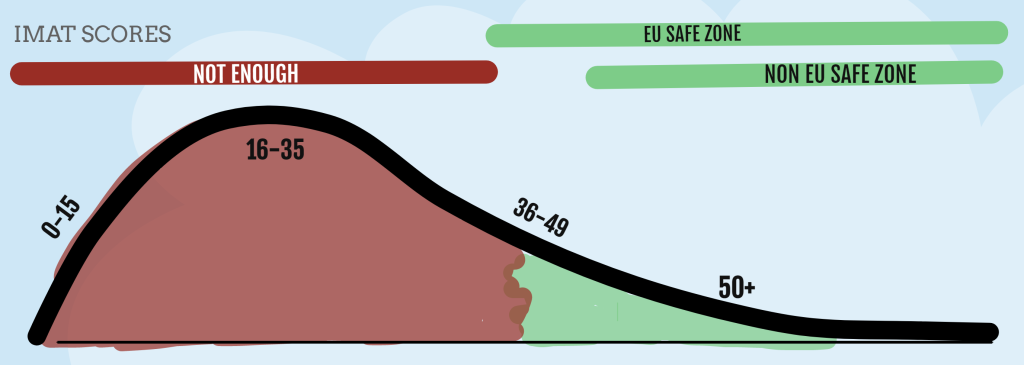

Ari Horesh University of Pavia, Italy
13th of November, 2023In this comprehensive article, we delve into the evolving landscape of the IMAT exam, particularly highlighting the notable shift in 2023 where the focus expanded substantially on biology questions. This trend not only simplified the exam for many but also significantly influenced the overall results and trends observed. The competition, especially for non-EU students, has been escalating steadily each year, adding to the exam’s intensity. We’ll analyze these new trends in-depth, provide insightful advice for those preparing for IMAT 2024, and offer a glimpse of what to expect in the coming year. This guide aims to equip aspiring medical students with the knowledge and strategies needed to excel in securing a place in their desired English-taught medical programs at Italian universities.


Content Quick Navigation
What is a Good IMAT Score?




The illustration above was made a few years back, now, the Non-EU safe zone would be above 50!
In 2023, the IMAT exam underscored a significant distinction between EU and non-EU candidates, particularly in their approach to different sections of the exam. This trend validated the observations made in 2022, revealing that EU candidates could afford to pay less attention to the math and physics sections. In contrast, for non-EU candidates aiming for high scores, neglecting these sections is no longer a viable strategy. To achieve a competitive edge, non-EU candidates need to score above 52-53, which emerged as the average cutoff in 2023.
Securing a good IMAT score is crucial for admission to your desired medical school in Italy. While the definition of a ‘good’ score is subjective, influenced by factors like competition level, seat availability, and your EU or non-EU status, there are clear trends to consider. EU candidates typically require lower scores due to the scrolling system, which offers more flexibility in university selection. However, the dynamics for non-EU candidates are more stringent. In 2023, it became evident that non-EU candidates should target scores above 55 to stand a fair chance of admission to top medical schools, as compared to the around 45 score (and even a bit less) for EU candidates. This advice is especially relevant given that cutoff scores vary annually and can be higher for certain prestigious institutions.
What should you expect for IMAT 2024?
The trends in IMAT scores have shown consistency with minor fluctuations over recent years, primarily influenced by changes in the exam’s format and difficulty level. The 2023 IMAT, marked by an increased number of math and physics questions, a significant amount of Biology questions and a heightened difficulty level, led to a notable decrease in the minimum scores and rankings required to pass.
Moving forward, the adaptation in format and difficulty has provided students with a clearer picture of what to expect in the IMAT 2024. This familiarity, combined with unchanged subject matter, positions well-prepared students at an advantage. Despite the format and difficulty alterations, the core subjects remain constant, reinforcing the importance of comprehensive preparation and deep understanding of the necessary topics and concepts.
The competition for medical school admissions in Italy remains fiercely high, necessitating students to aim for top scores. It’s advisable for students to begin their preparation early, utilizing quality study materials and practice tests to hone their knowledge and exam skills.
With students getting acclimatized to the new exam structure, we anticipate a rise in scores for IMAT 2024. Thorough preparation and a strategic approach are key to enhancing admission chances. Our projections suggest that for non-EU students, the cutoffs in the upcoming year could be significantly high, possibly ranging between 55-60. In contrast, EU candidates, benefiting from the scrolling system, might face relatively lower cutoffs, around 45. Thus, it’s crucial for aspirants to gear up and aim high to secure a place in their preferred Italian medical schools.
IMAT 2023 Minimum Scores
| University | Non-EU Seats | Non-EU Cut Off | EU Seats | 1st Round EU Cut Off |
|---|---|---|---|---|
| La Sapienza | 13 | 50.8 | 45 | 46.7 |
| Milano Statale | 25 | 60.2 | 55 | 47.6 |
| Pavia | 40 | 53.3 | 103 | 39.8 |
| Bologna | 20 | 59.1 | 97 | 43.9 |
| Padova | 20 | 49.5 | 80 | 41.1 |
| Tor Vergata | 15 | 53.4 | 40 | 40.2 |
| Turin | 32 | 49 | 70 | 39 |
| Bicocca | 18 | 54.2 | 30 | 46.3 |
| Federico II | 25 | 52 | 15 | 45.9 |
| Parma | 45 | 50.1 | 75 | 37.6 |
| Messina | 56 | 36.9 | 55 | 35.2 |
| Luigi Vanvitelli | 50 | 47.3 | 60 | 37 |
| Bari | 11 | 31.2 | 69 | 36.2 |
| Catania | 0 | – | 60 | 34.9 |
| Marche (Ancona) | 55 | 43 | 25 | 37.5 |
| Siena (Dentistry) | 12 | 51.3 | 25 | 37.5 |
| La Sapienza (Dentistry) | 6 | 59.1 | 19 | 40.3 |
IMAT 2023 Results Analyis
The IMAT 2023 results, when compared with the previous years (2022 and 2021), reveal intriguing trends and shifts in the exam’s competitive landscape, applicable to both EU and Non-EU candidates. This analysis aims to dissect these trends, offering insights and tips for prospective candidates.
Non-EU Score Trends
In 2023, we observed a notable increase in cutoff scores for Non-EU candidates at several universities. For instance, Milano Statale’s cutoff jumped to 60.20 in 2023, a significant rise from 51.8 in 2022 and 51.5 in 2021. Similar trends were seen in other universities like Bologna and La Sapienza (Dentistry). This increase in cutoffs can be linked to:
- Rising Number of Non-EU Applicants: An increase in applicants elevates competition, naturally pushing cutoffs higher.
- Shift in Exam Focus to Biology: The exam in 2023 had a heavier emphasis on biology, benefiting those with a strong background in this subject.
- Simplified Exam Format: The exam’s more straightforward format, combined with fewer general knowledge and easier logic questions, may have led to higher overall scores.
- Improved Preparation Strategies: Enhanced preparation courses in 2023 could have better equipped students, contributing to the higher scores.
- Percentiles Indication: Remarkably, a score of about 56 in 2023 placed candidates in the top 1%, indicating a higher general performance.
EU Score Trends
For EU candidates, the trends are slightly different. While some universities, like Milano Statale and Bicocca, maintained high cutoffs, others like Parma and Messina showed a decrease or stability in cutoff scores. This variance suggests:
- Consistent Exam Format and Difficulty: Despite the exam being the same for EU and Non-EU students, the response to changes might differ due to varied preparation approaches and competition levels.
- Impact of Scrolling System: The scrolling system for EU students provides a cushion, possibly affecting how aggressively they aim for high scores.
Comparative Analysis Across Universities
When comparing universities, it’s evident that prestigious universities like Milano Statale and La Sapienza consistently demand higher scores due to their reputation and demand. In contrast, universities with a larger number of seats, like Pavia and Messina, tend to have lower cutoffs.
Tips for Prospective Candidates
- Understand the Weightage: With the increased emphasis on biology, candidates should allocate more preparation time to this subject.
- Early and Comprehensive Preparation: Starting early and using high-quality study materials is key especially if you are Non-EU. Practice exams are crucial to familiarizing yourself with the new exam format.
- Focus on Strengths: While a balanced preparation is essential, strengthening your strong areas can help you maximize your score.
- Aim for High Percentiles: Aiming for top percentiles is crucial, especially for Non-EU students, as it significantly enhances admission chances. Don’t choose a university that you might score too low to enter – the scores are very high!
Remember, every point counts in this competitive environment, so strategic preparation and a thorough understanding of the exam are key.

